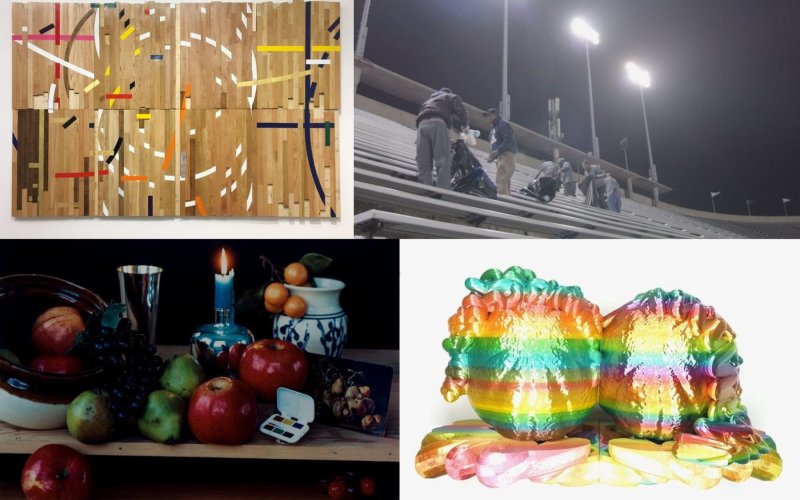Three Exhibitions Open Spring Season at University Art Museum

ALBANY, N.Y. (Jan. 25, 2022) — Three new exhibitions open today at the University Art Museum: multi-media artist Ronny Quevedo’s “offside” in the main gallery, Rodrigo Valenzuela’s “Video Works” in the Nancy Hyatt Liddle Gallery on the second floor, and “Fruit Soup: Contemporary Vanitas by Audrey Flack and Gracelee Lawrence” in the Collections Study Gallery.
Quevedo’s family’s emigration from Ecuador to New York serves as a catalyst for his works on display (2012 to the present), which reflect on socio-political issues of migration, Indigenous architecture and communal spaces.
One newly commissioned work, “fuera de lugar” (2021), uses diagrammatic vinyl lines that recall both dress patterns and gymnasium floors, a reference to his seamstress mother and professional soccer player father. Another new commission, “a mother’s hand” (2021), uses grids that reference both pre-Columbian textiles and the modularity in the 1960s design by Edward Durell Stone of the museum in which this work is sited.
Upstairs in the Nancy Hyatt Liddle Gallery are two video works by multi-disciplinary artist Rodrigo Valenzuela. A former day laborer in landscape, construction and other sectors, Valenzuela frequently draws an analogy between soccer goalkeepers and his former job on an overnight crew cleaning office buildings. In the two videos on view, “Prole” (2015) and “El Sísifo” (2015), sports provide a backdrop for investigating issues of race, labor, solidarity and workers’ agency.
Both videos shed light on the unseen labor behind the spectacles of sports and capitalism, inviting reflection on how labor is regarded in U.S. society and the effect that status has on real lives.
You can hear more from Quevedo and Valenzuela at their Artist Talk, scheduled from 4:30-5:30 p.m. on Thursday, March 3, followed by an Artists’ Reception from 5:30-7 p.m. at the Museum.
In the Collections Study Gallery
Photographs from the University’s Fine Art Collections by photorealist painter Audrey Flack and recent 3D printed sculptures by Gracelee Lawrence, currently a visiting assistant professor of sculpture, art and art history, share unexpected commonalities in the joint exhibition in the Collections Study Gallery.
Flack’s photographs use an intricate three-layer (cyan, magenta, yellow) dye-transfer process and function as sources for her groundbreaking vanitas still lifes from the 1970s and early 1980s. Lawrence’s objects — which begin as 3D scans of bodies and fruit and were then printed in multi-colored, reflective filaments — exist in a transfigurative space between physical and digital reality. Paired together, Flack’s and Lawrence’s works provide meditations on time and subjectivity, mechanical and digital reproduction, and capitalist consumption in our contemporary world.
The two artists’ works are paired as vanitas — a style popular in 17th century Holland. The word is based on the Latin for vanity and describes a still life that includes objects such as skulls and ripe fruit, meant to remind the viewer of their own mortality and the transient nature of life. Flack’s photographs reflect reoccurring themes such as life and death, luxury and consumption.
Lawrence’s work in “Fruit Soup” explores these themes through digitally-skewed fruits and vegetables, representing hybridity, reproduction, humor and sexuality. The objects are all printed with polylactic acid (PLA) filament, a vegetable derived bioplastic typically made from fermented corn starch. In what the artist calls a “material poetics,” the works ask us to consider produce as a vehicle for understanding systems of power and control, nutrition and intimacy, and technological invention.
Creating a space for new ideas like these to emerge from visual dialogue is central to the Collections Study Gallery mission. The gallery’s rotating exhibition schedule highlights artworks from the Collections with past exhibiting artists and/or emerging or established contemporary artists, and works in tandem with the Collections Study Space, giving access to 3,000 objects reflecting students, faculty, other researchers and scholars, and the community.
All three exhibitions will be on display through April 2. The Museum is open 11 a.m. - 4 p.m. Tuesday through Saturday, and visitors must wear face masks. Hours are subject to change; for up-to-date information visit the Museum website or call 518-443-4035.




